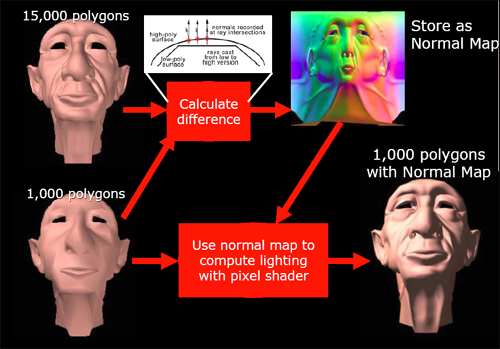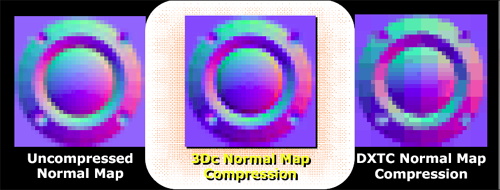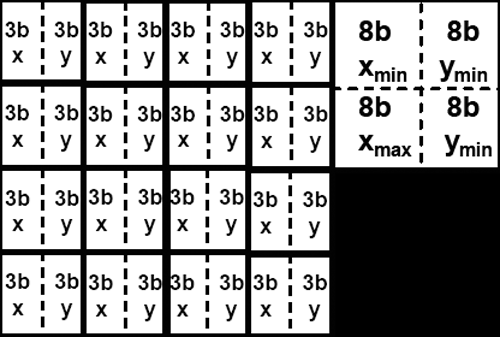ATI Radeon X800 Pro and XT Platinum Edition: R420 Arrives
by Derek Wilson on May 4, 2004 10:28 AM EST- Posted in
- GPUs
A New Compression Scheme: 3Dc
3Dc isn't something that's going to make current games run better or faster. We aren't talking about a glamorous technology; 3Dc is a lossy compression scheme for use in 3D applications (as its name is supposed to imply). Bandwidth is a highly prized commodity inside a GPU, and compression schemes exist to try to help alleviate pressure on the developer to limit the amount of data pushed through a graphics card.
There are already a few compressions schemes out there, but in their highest compression modes, they introduce some discontinuity into the texture. This is acceptable in some applications, but not all. The specific application ATI is initially targeting for use with 3Dc is normal mapping.
Normal mapping is used in making the lighting of a surface more detailed than is its geometry. Usually, the normal vector at any given point is interpolated from the normal data stored at the vertex level, but, in order to increase the detail of lighting and texturing effects on a surface, normal maps can be used to specify the way normal vectors should be oriented across an entire surface at a high level of detail. If very large normal maps are used, enormous amounts of lighting detail can produce the illusion of geometry that isn't actually there.

Here's an example of how normal mapping can add the appearance of more detailed geometry
In order to work with these large data sets, we would want to use a compression scheme. But since we don't want discontinuities in our lighting (which could appear as flashy or jumpy lighting on a surface), we would like a compression scheme that maintains the smoothness of the original normal map. Enter 3Dc.

This is an example of how 3Dc can help alieve continuity problems in normal map compression
In order to facilitate a high level of continuity, 3Dc divides textures into four by four blocks of vector4 data with 8 bits per component (512bit blocks). For normal map compression, we throw out the z component which can be calculated from the x and y components of the vector (all normal vectors in a normal map are unit vectors and fit the form x^2 + y^2 + z^2 = 1). After throwing out the unused 16 bits from each normal vector, we then calculate the minimum and maximum x and minimum and maximum y for the entire 4x4 block. These four values are stored, and each x or y value is stored as a 3 bit value selecting any of 8 equally spaced steps between the minimum and maximum x or y values (inclusive).

The storage space required for a 4x4 block of normal map data using 3Dc
the resulting compressed data is 4 vectors * 4 vectors * 2 components * 3 bits + 32 bits (128 bits) large, giving a 4:1 compression ratio for normal maps with no discontinuities. Any two channel or scalar data can be compressed fairly well via this scheme. When compressing data that is very noisy (or otherwise inherently discontinuous -- not that this is often seen) accuracy may suffer, and compression ratio falls off for data that is more than two components (other compression schemes may be more useful in these cases).
ATI would really like this compression scheme to catch on much as ST3C and DXTC have. Of course, the fact that compression and decompression of 3Dc is built in to R420 (and not NV40) won't play a small part in ATI's evangelism of the technology. After all is said and done, future hardware support by other vendors will be based on software adoption rate of the technology, and software adoption will likely also be influenced by hardware vendor's plans for future support.
As far as we are concerned, all methods of increasing apparent useable bandwidth inside a GPU in order to deliver higher quality games to end users are welcome. Until memory bandwidth surpasses the needs of graphics processors (which will never happen), innovative and effective compressions schemes will be very helpful in applying all the computational power available in modern GPUs to very large sets of data.










95 Comments
View All Comments
raks1024 - Monday, January 24, 2005 - link
free ati x800: http://www.pctech4free.com/default.aspx?ref=46670Ritalinkid - Monday, June 28, 2004 - link
After reading almost all of the video cards reviews posted on anandtech I start to get the feeling the anandtech has a grudge against nvidia. The reviews seem to put nvidia down no matter what area they excel in. With leading openGL support, ps3.0 support, and the 6850 shadowing the x800 in directX, its seems like nvidia should not be counted out as the "best card."I would love to see a review that tested all the features that both cards offered especially if showed the games that would benefit the most from each cards features (if they are available). Maybe then could I decide which is better, or which could benefit me more.
BlackShrike - Saturday, May 8, 2004 - link
Hey if anyone is gonna be buying one of these new cards, would anyone want to sell their 9700 pro or 9800 por/Xt for like 100-150 bucks? If you do contact me at POT989@hotmail.com. Thanks.DonB - Saturday, May 8, 2004 - link
No TV tuner on this card either? Will there be an "All-In-Wonder" version soon that will include it?xin - Friday, May 7, 2004 - link
(my bad, I didn't notice that I was on the first page of the posts, and replied to a message there heh)Well, since everyone else is throwing their preferences out there... I guess I will too. My last 3 cards have been ATI cards (9700Pro & 9500Pro, and an 8500 "Pro"), and I have not been let down. Right at this moment I lean towards the x800XT.
However, I am not concerned about power since I am running a TruePower550, and I will be interested in seeing what happens with all of this between now and the next 4-6 weeks when these cards actually come to market... and I will make my decision then on which card to buy.
xin - Friday, May 7, 2004 - link
Besides that, even if it were true (which it isn't), there is a world of difference between have *some* level of support, and requiring it. (*some* meaning the intial application of PS3.0 technology to games, that will likely be as sloppy as your first time in the back of a car with your first girlfriend).
Game makers will not require PS3.0 support for a long long long time... because it would alienate the vast majority of the people out there, or at least for the time being any person who doesn't have a NV40 card.
Some games may implement it and look slightly better, or even still look the same only run faster while looking the same.... but I would put money down that by the time PS3.0 usage in games comes anywhere close to mainstream, both mfg's will have their new, latest and greatest cards out, probably a 2 generations or more past these cards.
xin - Friday, May 7, 2004 - link
first of all... "alot of the upcoming topgames will support PS3.0!" ??? They will? Which ones exactly?
Z80 - Friday, May 7, 2004 - link
Good review. Pretty much tells me that I can select either Nvidia or ATI with confidence that I'm getting alot of "bang for my buck". However, my buck bang for video cards rarely exceeds $150 so I'm waiting for the new low to mid range cards before making a purchase.xin - Friday, May 7, 2004 - link
I love how a handful of stores out there feel the need to rip people off by charing $500+ for the x800PRO cards, since the XT isn't available yet.
Anyway, something interesting I noticed today:
http://www.compusa.com/products/product_info.asp?p...
http://www.compusa.com/products/product_info.asp?p...
Notice the "expected ship date"... at least they have their pricing right.
a2y - Friday, May 7, 2004 - link
Trog, I Also agree, the thing is.. its true i do not have complete knowledge of deep details of video cards.. u see my current video card is now 1 year old (Geforce4 mx440) which is terrible for gaming (50fps and less) and some games actually do not support it (like deusEX 2). I wanted a card that would be future proof, every consumer would go thinking this way, I do not spend everything i earned, but to me and some others $400-$500 is O.K. If it means its going to last a bit longer.I especially worry about the technology used more than the other specs of the cards, more technologies mean future games are going to support it. I DO NOT know what i'v just said actually means, but I fealt it during the past few years and have been affected by it right now (like the deus ex 2 problem!) it just doesn't support it, and my card performs TERRIBLY in all games
now my system is relatively slow for hardcore gaming:
P4 2.4GHz - 512MB RDRAM PC800 - 533MHz FSB - 512KB L2 Cache - 128MB Geforce4 mx440 card.
I wanted a big jump in performance especially in gaming so thats why i wanted the best card currently available.